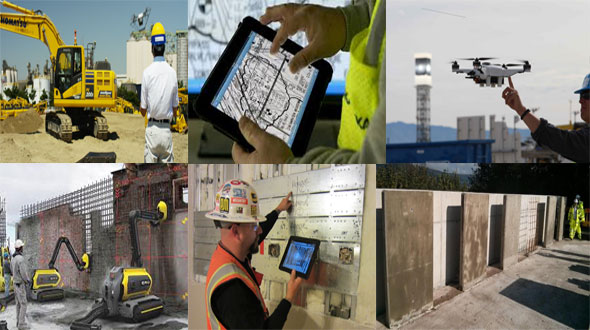Some emerging construction technologies in 2016
- Concrete Cost Estimator
- Concrete Continuous Footing
- Landscape Bidding and Estimating
- Construction Cost Estimating
- Concrete and steel cost estimation
- Construction Cost Estimate Breakdown
- Construction Estimating Worksheet
- Home Construction Cost Estimate
- Estimate Pricing Sheet
- Sheet for General Contractor
- Construction Cost Estimate
- Labor Materials Cost Estimator
- Masonry Estimating Sheet
- Sheet for Building Contractor
- Construction Schedule Bar chart
- General Cost Estimator Sheet
- General Construction Estimate
- Building and Road Estimating Sheet
- Detailed expense estimates
- Door and Window Takeoff Sheet
- General Construction Cost Estimating Sheet

In recent times, there has been significant improvements in construction technologies. Some advanced technologies like mobile tech, cloud computing, big data etc. have emerged out for the successful completion of any construction project.
Give below, some of the leading construction technologies in 2016 :-
1) Drones: Drones are considered as globally all-embracing technology for Contractors. Drones are used by the contractors for a slew of projects together with flying by night to create blueprint for project sites and terrains. The drones can also be used to outline entire buildings. The contractors are using drones to accomplish different types of special work, risky inspections in project site, reach unsafe location, oversee advancement in project site etc. Drones can bring huge ROI for the construction projects as well as curtail labor and time almost in half.
2) Digital Forms: Now-days the contractors and subcontractors are planning to use digital forms extensively in 2016. Digital forms are very use for concrete construction. Digital forms provides daily reports and testing result reports and support various digital devices like tablets, PC’s, laptops, and phones. This construction technology can accelerate the process for generating reports as well as distribute reports to customers and make billing simpler.
Digital forms automate the process for sending reports and billing. Therefore, quick reporting and automation lead to quicker turnaround time that finally results in executing projects more rapidly as well as a much higher capital gaining.
3) Mechanical Devices: Mechanical devices are mainly utilized for testing and supervising purposes. These devices are considered as IoT (Internet of Things) devices where they can be linked with the platforms where mass information and data are being fed. This powerful construction technology is basically setting the foundation for contractors and subs to serve for everything on the construction site, from materials to building projects, through data acquired via mechanical devices.
Mechanical devices offer a good platform to transmit specific information into one integrated form that can checked easily. By linking sensors and an Internet connection, data is accumulated onto one board with prosecutable information that facilitates the contractors to undertake rational decisions prior to face any issue. The mechanical conveys useful data for the status of a project to the health status of an actual building and which become essential to a construction project.
4) Building Supply Manufacturers: Building supply manufacturers is another most discussed technology in 2016. The technology facilitates the manufacturers to implant products with sensors prior to they arrive into the project site. Implanting sensors into infrastructure components may result in obtaining data and tracking things in buildings actively. By implanting sensors into a 2×4 or an I-beam, a materials manufacturer can obtain an electromagnetic map of the whole construction area. This concept is useful for mapping people and things on a construction site with utmost perfectness. Besides, it can resolve the construction industry’s major issue - tracking.

Ref: zbrella.com
By pre-embedding, the whole lifecycle of a building can be monitored from its point of origin to well after its project accomplishment date, facilitating you to identify ecological factors concerning the building at all times, when replacing of products is required, when products start to decay etc. The contractors can keep a close eye on the vital aspects of the project.
GENESI Project is another emerging technology that uses a generation of green wireless sensor networks into buildings and infrastructure while developing the building to track and control intelligence over the structure’s whole lifetime. The contractors will be able to keep tract everything from vibrating strain gauges to displacement meters, pressure sensors to temperature sensors, and soil moisture sensors.
- Application of concrete calculator
- Roofing Calculator can streamline the roof estimating process
- House construction cost calculator
- Engineering column design excel spreadsheet
- Material Estimating Sheet with Excel
- Materials List and Cost Estimate Worksheet
- Concrete Slab Estimating Calculator Sheet
- Common types of foundations for buildings
- Online calculation of construction materials
- Estimating with Excel for the Small Contractor
- Concrete Beam Design Spreadsheet
- Virtual Construction Management app for construction
- Autodesk’s Project Skyscraper
- Reed Construction’s Reed Insight
- Manage your construction project documentation
- Costimator, the popular cost estimating software
- On Center Software for construction professionals
- Free Construction Estimating Software
- Plumbing Calc Pro
- Cost Estimate Worksheet
- HVAC Piping Quantity Takeoff Worksheet
- Construction Estimating Software Sheet
- Estimate Cost Templates
- Construction Punch List
- Construction cost estimating template consisting estimating basic
- Gantt Chart Template for Excel
- Download Civil Engineering Spreadsheets with Verification
- The Building Advisor Estimating and Budgeting Worksheet
- Spreadsheet for design of concrete bridge
- Construction Estimating Software Free








